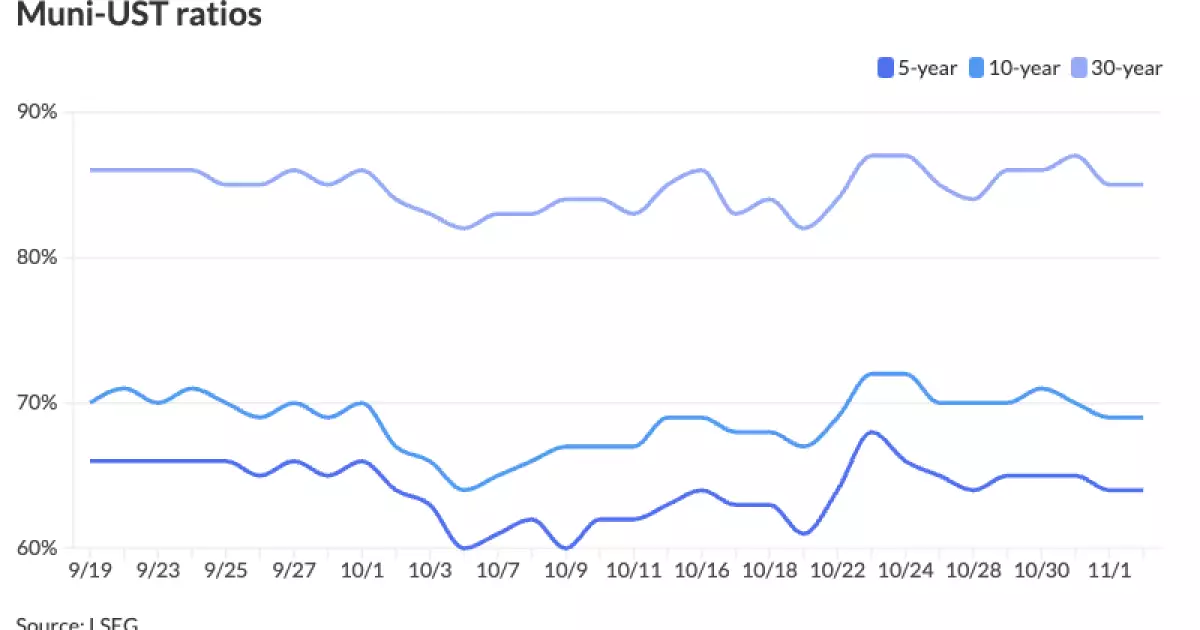As markets navigate through a pivotal week marked by the confluence of critical political and monetary events, municipal bonds are exhibiting signs of strength. Investors are anticipating turbulence following election results and decisions from the Federal Open Market Committee (FOMC) that could impact interest rates. On Monday, U.S. Treasury yields experienced a decline, particularly in longer maturities, while equities showed a downward trend approaching the market close. In this context, the two-year municipal to U.S. Treasury (UST) ratio stood at 63%, foreshadowing a slightly firmer municipal market amidst the uncertainty.
The conversation among market analysts indicates a palpable sense of anticipation as the election nears. Municipal portfolio managers, such as Daryl Clements at AllianceBernstein, are preparing for the aftershocks that the electoral outcome might bring. Daryl highlights the potential for a “knee-jerk reaction” from both yields and inflation expectations regardless of whether a red or blue wave occurs during the elections. These expectations set the stage for market participants to brace themselves for volatility, while recognizing that the composition of the government could lead to different implications for the bond market.
The results of the upcoming election are anticipated to significantly influence the municipal market. Analysts have pointed out that a divided government might be the most favorable scenario for the bond market, as legislative inertia could lead to a stabilization of yields and lower inflation expectations. Conversely, a unified government may expedite policy changes that could prove more disruptive to the bond market, depending on the party in power.
The recent observations from market strategists indicate that the municipal sector has demonstrated resilience. With a week of reduced volumes expected due to the election’s proximity, market participants are nevertheless optimistic. The insights shared by Tom Kozlik from Hilltop Securities suggest that the market may experience a brief stalemate until the political picture becomes clearer. The uncertainty surrounding both the elections and the impending FOMC meeting elevates the stakes for investors, leaving many pondering the future direction of yields.
Federal Open Market Committee and Macroeconomic Influences
In addition to the electoral uncertainties, the market is also focused on the forthcoming FOMC meeting. With the backdrop of last month’s significant 50-basis-point rate cut, analysts have introduced various scenarios. While the Fed may decide to implement further cuts, there remains a small possibility of pausing actions entirely. The mixed economic data that has recently emerged—particularly regarding GDP growth and labor market statistics—has added layers of complexity to these considerations.
The third-quarter GDP estimate came in slightly below expectations at 2.8%, while job creation figures were disconcertingly weak, with only 12,000 jobs added compared to a forecast of 112,000. These economic indicators play a crucial role in guiding Fed decisions, underscoring a data-dependent approach to monetary policy going forward.
Given the current state of the municipal market, the influx of demand is noteworthy. Recent reports have shown substantial inflows into municipal mutual funds, totaling over $659 million for the week, representing 18 consecutive weeks of positive fund flows. Birch Creek strategists have noted that as investors recalibrate their strategies in response to shifting yield levels and increasing seller realism, the market might witness the largest volume of trading activity seen in months.
However, as December approaches, decreased issuance is anticipated due to seasonal factors, including the holidays and election outcomes. A substantial deal from the Texas Municipal Gas Acquisition and Supply Corp., despite the subdued primary market, illustrates that investors continue to seek opportunities even in uncertain times.
Moreover, the technical outlook for the municipal market is projected to improve as insatiable demand clashes with a dwindling supply of new issues. Analysts predict that this mismatch will catalyze a favorable technical backdrop for municipal bonds over the coming months, potentially bolstering their performance.
Final Thoughts
As the municipal bond market braces for an uncertain future driven by electoral outcomes and monetary policy decisions, several key trends are shaping investor sentiment. The interplay between rising demand and constrained supply will likely create an environment conducive to increased municipal bond performance. While the political impact might introduce volatility in the short term, the overall trajectory suggests a moderate decline in yields over the longer term. As investors navigate this complex landscape, the important takeaway remains: preparation for varied outcomes will be essential as we approach this transformative period for the municipal bond market.


Leave a Reply